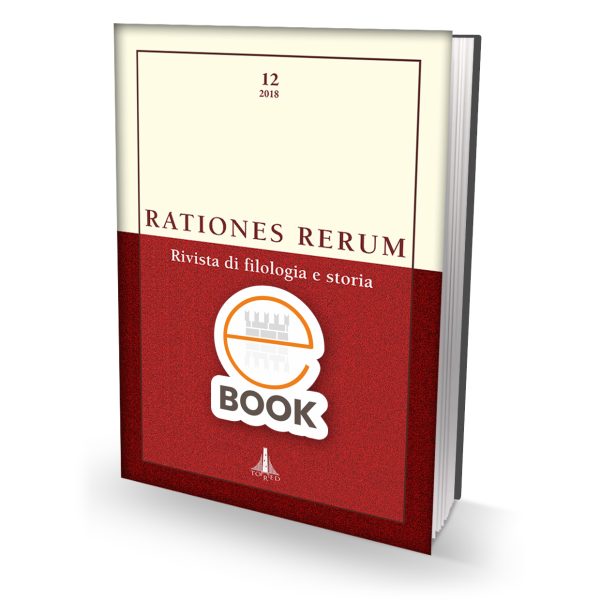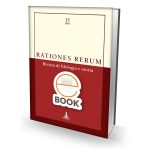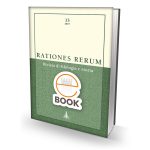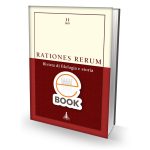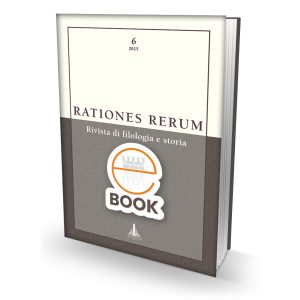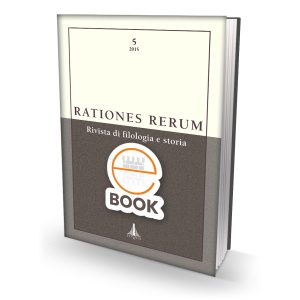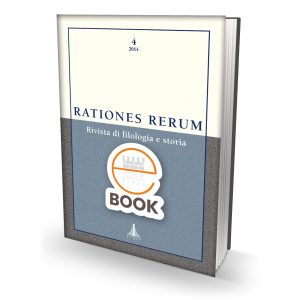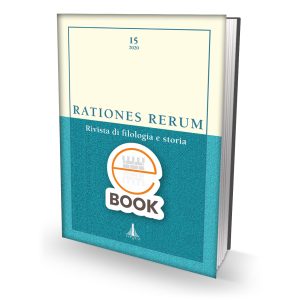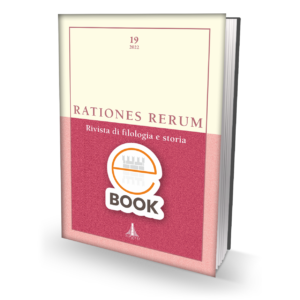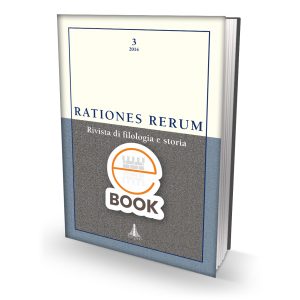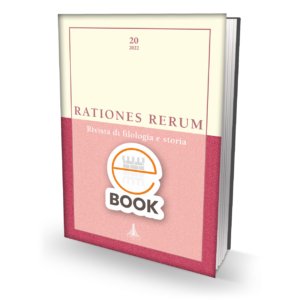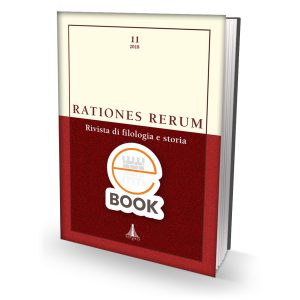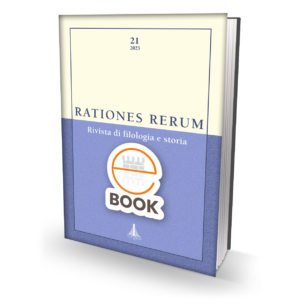RATIONES RERUM 12 – Rivista di filologia e storia (E-book)
25,00 €
Autori vari
Anno edizione: 2018
Formato 17×24 – Pagine 283
ISBN 9788899846558 – ISSN 2284-2497
Prezzo: € 25,00
- Descrizione
- ANTEPRIMA
- ABSTRACTS
Descrizione
Sommario
Wanda Nobile, Eumelo e la costruzione della genealogia regale corinzia. Riflessioni intorno a FGrHist 451 Fia-b, p. 9
Gabriella Vanotti, Cimone a Tanagra e nel dopo Tanagra, p. 35
Gabriella Ottone, L’antagonista “Tyrios” di Evagora a Salamina di Cipro. Nuove considerazioni su Diod. 14, 98, 1, p. 69
Generoso Cefalo, Apollodoro tiranno di Cassandreia da nemico di Antigono Gonata a exemplum di crudeltà tirannica, p. 87
Maria Chiara Garasto, A proposito del commento di Pomponio Leto alla prima Catilinaria di Cicerone (Vat. Lat. 3233), p. 109
Massimiliano Valenti, Una inedita carta archeologica di Tusculum e gli scavi promossi da Luciano Bonaparte, tra antiquari, architetti e vedutisti, p. 135
Daniele Fusi, Recovering Legacy in the Digital World: Tales and Tools, p. 203
Recensioni
Francisco J. González Mora, rec. a Bartolomé Segura Ramos, Ensayo sobre la Ilíada, Sevilla, editorial Thémata (“Pensamiento”, 26) 2016, p. 263
Maria Barbara Savo, rec. a B.B. Sebastiani – D. Leão – L. Sano – M. Soares – Chr. Werner (coords.), A poiesis da democracia, Coimbra Companion, Coimbra, Imprensa da Universidade de Coimbra, 2018, p. 266
Abstracts, p. 277
Indice analitico (a cura di Carlo Di Giovine), p. 281
Istruzioni per gli autori, p. 285
Wanda Nobile
Eumelo e la costruzione della genealogia regale corinzia. Riflessioni intorno a FGrHist 451 Fia-b
pp. 9-33
This article analyzes a fragment from the Korinthiaka of the poet Eumelos of Corinth (FGrHist 451 F1a = PAUS. 2, 1, 1; F1b = Schol. in Ap. Rhod. 4, 1212/1214b) concerning the first section of the Corinthian royal genealogy. In particular, the paper focuses on Eumelos’ equivalence Corinth = Ephyra, a site cited in the Iliad as the kingdom of Sisyphos. The Homeric verses, as well as two passages of Simonides, show that the overlaying of these two entities is a post-Iliadic production, which reflects Eumelos’ desire to connect the corpus of Ephyra’s epic traditions to Corinth. Through the genealogy he creates, and by citing Ephyra as the ancient name of Corinth, he aspires to legitimize Sisyphos’ presence at Corinth.
Gabriella Vanotti
Cimone a Tanagra e nel dopo Tanagra
pp. 35-67
The ten-year period 462/1 BC (Ephialtes’ reforms) – 452/1 (Five Years Peace) is full of events concerning both the foreign and the internal policy of Athens: the so-called reforms of Ephialtes, the ostracism of Kimon, Perikles’ intervention in Egypt in support of Inaros, the war against Aegina, the battles of Tanagra and Oenophyta, and, finally, Kimon’s recall before the Five Years Peace. Therefore, it is difficult not only to trace the course of events, but also to understand the political and ideological trends which caused them. The paper’s aim is to discuss some aspects of this complex historical period in the light of the few (and very problematic) accounts provided by Thucydides, Theopompus, Diodorus, and Plutarch.
Gabriella Ottone
L’antagonista “Tyrios” di Evagora a Salamina di Cipro. Nuove considerazioni su Diod. 14, 98, 1
pp. 69-85
This paper focuses on the obscure figure of a ruler of Salamis of Cyprus known from the ancient tradition as the antagonist of Evagoras at the time during which the latter seized power in his homeland. Despite the partiality and fragmentation of the traditional data, a careful analysis of the few surviving sources allows for a re-reading of all the information in the light of the contemporary historical and ideological context, characterized both by the struggles between the Cypriot dynasties and also by propagandistic strategies implemented by Evagoras to legitimate his imperialist policy.
Generoso Cefalo
Apollodoro tiranno di Cassandreia da nemico di Antigono Gonata a exemplum di crudeltà tirannica
pp. 87-107
Apollodoros was the tyrant of Cassandreia from about 279 BC until 276 BC. The first section of the paper sketches the main events of his life, arguing that he represented a serious threat to Antigonos Gonatas. The second section focuses on the two main literary traditions about Apollodoros, suggesting that the first narrative was elaborated by Hieronymus of Cardia and Lykophron the Tragedian in order to discredit him. Later, anonymous λογογράφοι composed the second account, comparing Apollodoros to Phalaris and portraying the former as an exemplum of tyrannical cruelty. The two tyrants were probably compared since they shared two “tyrannical” practices: human sacrifices and cannibalism.
Maria Chiara Garasto
A proposito del commento di Pomponio Leto alla prima Catilinaria di Cicerone (Vat. Lat. 3233)
pp. 109-134
This paper examines the autograph commentary of Pomponius laetus on Cicero’s First Catilinarian, preserved in the codex Vat. lat. 3233 (ff 42v-53r), annotated by the same author in the margins, and intended for public teaching in the years 1470-1480. The commentary takes an essentially didactic approach and shows the multiple interests of Pomponius, who, taking his cue from the First Catilinarian, first introduces its genre and sections, then concentrates on the main topics of this speech: Roman institutions and magistracies, city topography, use of Greek words, metrical figures, rhetorical themes, etymologies, and religion.
Massimiliano Valenti
Una inedita carta archeologica di Tusculum e gli scavi promossi da Luciano Bonaparte, tra antiquari, architetti e vedutisti
pp. 135-202
This article presents a critical edition of a very rare print owned by the Museum of the City of Monte Porzio Catone (Rome) that illustrates the archaeological investigations of ancient Tusculum up to the year 1820. The document, conceived and produced in a French cultural environment, comprises an extensive central archaeological map of a high technical level, a detailed documentation of the individual monuments, and brief descriptive notes on the historical background of the archaeological site. Such documentation is compared with numerous and also unpublished archive documents, which reflect an echo of the discoveries made on the property of Luciano Bonaparte (Villa Rufinella, near Frascati) and the frequent visits to that location by some of the most important 19th century designers and architects.
Daniele Fusi
Recovering Legacy in the Digital World: Tales and Tools
pp. 203-262
Given the well-known issues arising from the short lifespan of many legacy digital resources, this paper describes through real-world test cases a generic-purpose, modular, and reusable framework for recovering digital formats in addition to paper-based resources. Ranging from legacy and/or proprietary formats and even character-encodings (including well-known legacy technologies such as Beta code or SAMPA), raw digitized editions and textual corpora, critical editions, dictionaries, and other highly structured texts, up to totally different resources like documental archives, the same framework provides different flows all targeted for recovery, in the most pregnant of its meanings. often, the recovery is not only the mere act of swapping a serialization technology with another; rather, it implies a more or less involved remodeling of legacy data targeted to a paper-based world, by transforming a typographically oriented structure into a semantic one. This cannot be achieved without significant effort, but such systems can alleviate the task, and even further enlighten the features, of the implementation of truly digital resources in digital humanities. A critical edition of Priscian’s book XVIII offers a test case for illustrating this point.

